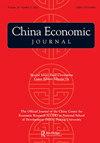Introduction to the special issue
IF 2.3
Q1 ECONOMICS
引用次数: 0
Abstract
The global economic growth has slowed down due to both the pandemic effects and the de-globalization. The world trade organization (WTO), as the most important representative organization of global multilateral economic corporations, is under threat due to the ineffective enforcement of its dispute settlement committee. Many countries, especially advanced economics, are suffered from the negative shocks and results in a negative economic growth in 2020. However, China, as the current largest developing country and the second-largest economy in the world, still realized a modest economic growth of 2.3% in 2020, when the pandemic was the most severe. This observation indeed raises two issues. First, as a locomotive of the whole world’s economic growth, how can China find a way to maintain its sustainable economic growth in the coming years? Second, how can China further open up to address the challenge of de-globalization caused by the weakened global multilateral economic corporation? Given China accounted for around 18% of global GDP in 2020, China’s sustainable economic growth and deep integration into the global economy are important not only for China but also for the rest of the world. To answer the first question, in this special issue, Justin Lin provides an insightful analysis of the dual-circulation development strategy advocated by the Chinese government. Notably, Justin discusses the following three questions: First, why does China put a particular focus on domestic circulation? Second, why is it important to fully employ both domestic and international resources and markets? Third, how will China structure its new development pattern? Justin forcefully argues that it is crucial to tap development potential through structural reform for China’s dual circulation. In addition, it is necessary to deepen the reform and clear obstacles that constrain the development of domestic circulations and implement the measures for further opening up, and better leverage the international resources and markets. To further open up, China indeed puts a particular focus on the Regional Comprehensive Economic Partnership (RCEP) agreement. East Asian countries signed the RCEP in November 2020. As carefully analyzed by Peter Drysdale and Shiro Armstrong, the RCEP agreement consolidated the 10-member ASEAN’s free trade agreements and the three northeast Asian economic powers, China, Japan, and South Korea, along with Australia and New Zealand.特刊简介
由于疫情影响和去全球化,全球经济增长放缓。世界贸易组织(WTO)作为全球多边经济公司最重要的代表组织,由于其争端解决委员会的执行不力而受到威胁。许多国家,特别是发达经济体,遭受了负面冲击,导致2020年经济负增长。然而,中国作为目前最大的发展中国家和世界第二大经济体,在疫情最严重的2020年仍然实现了2.3%的适度经济增长。这一观察确实提出了两个问题。首先,作为全世界经济增长的火车头,中国如何找到在未来几年保持可持续经济增长的方法?第二,中国如何进一步开放,以应对全球多边经济公司削弱所带来的去全球化挑战?鉴于2020年中国约占全球GDP的18%,中国的可持续经济增长和深度融入全球经济不仅对中国很重要,对世界其他地区也很重要。为了回答第一个问题,林在本期特刊中对中国政府倡导的双循环发展战略进行了深入分析。值得注意的是,Justin讨论了以下三个问题:第一,为什么中国特别关注国内流通?第二,为什么充分利用国内外资源和市场很重要?第三,中国将如何构建新的发展格局?贾斯汀有力地指出,通过结构性改革挖掘中国双循环的发展潜力至关重要。此外,要深化改革,扫清制约国内大循环发展的障碍,落实进一步开放的措施,更好地利用国际资源和市场。为了进一步开放,中国确实特别重视区域全面经济伙伴关系协定。东亚国家于2020年11月签署了RCEP。正如Peter Drysdale和Shiro Armstrong仔细分析的那样,RCEP协议巩固了东盟10个成员国的自由贸易协定以及中国、日本和韩国这三个东北亚经济大国以及澳大利亚和新西兰。
本文章由计算机程序翻译,如有差异,请以英文原文为准。
求助全文
约1分钟内获得全文
求助全文

 求助内容:
求助内容: 应助结果提醒方式:
应助结果提醒方式:


